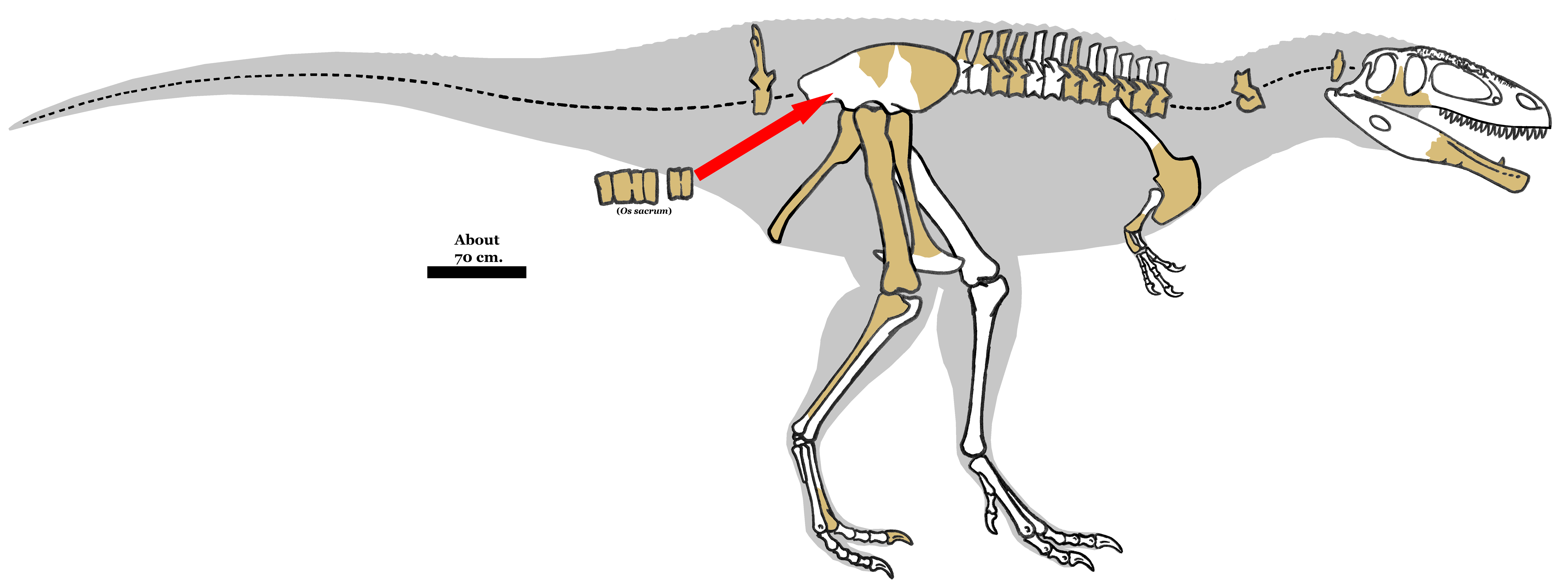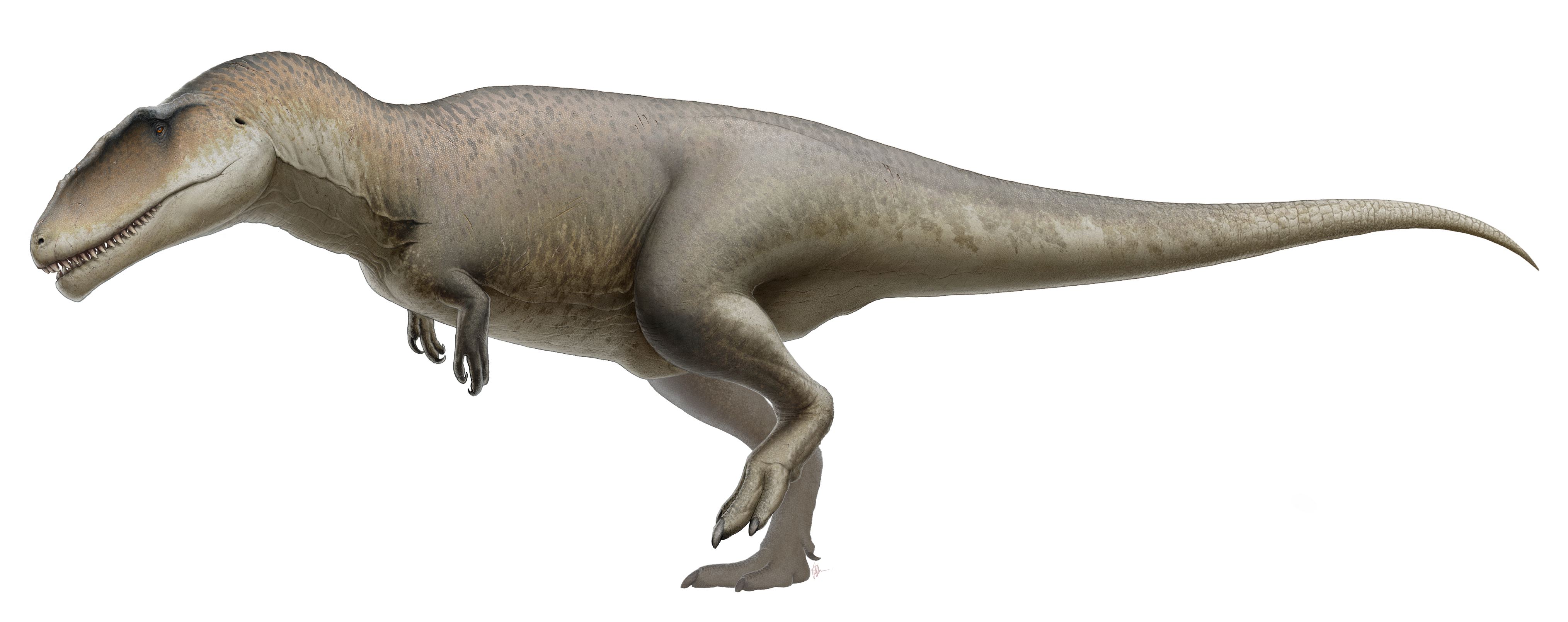|
Carcharodontosaurids
Carcharodontosauridae (carcharodontosaurids; from the Greek καρχαροδοντόσαυρος, ''carcharodontósauros'': "shark-toothed lizards") is a group of carnivorous theropod dinosaurs. In 1931, Ernst Stromer named Carcharodontosauridae as a family, which, in modern paleontology, indicates a clade within Carnosauria. Carcharodontosaurids include some of the largest land predators ever known: ''Giganotosaurus'', ''Mapusaurus'', ''Carcharodontosaurus'', and ''Tyrannotitan'' all rivaled or exceeded ''Tyrannosaurus'' in size. A 2015 paper by Christophe Hendrickx and colleagues gives a maximum length estimate of for the largest carcharodontosaurids, while the smallest carcharodontosaurids were estimated to have been at least long. Evolution Along with the spinosaurids, carcharodontosaurids were the largest predators in the early and middle Cretaceous throughout Gondwana, with species also present in North America (''Acrocanthosaurus''), Europe (''Concavenator'') and Asia ... [...More Info...] [...Related Items...] OR: [Wikipedia] [Google] [Baidu] |
Veterupristisaurus
''Veterupristisaurus'' is an extinct genus of carcharodontosaurid theropod dinosaur known from the Jurassic of Tendaguru, Lindi Region of southeastern Tanzania. Discovery and naming ''Veterupristisaurus'' is known from the holotype specimen MB R 1938, an isolated middle caudal vertebra. Two partially fused posterior middle caudal vertebrae, MB R 2166, from the same locality as the holotype, are referred to this genus and most probably came from the same individual. The anterior caudal vertebra, MB R 1940, may also represent this genus. The holotype was collected in the St (EH) locality of the Tendaguru in German East Africa, from the Middle Dinosaur Member of the Tendaguru Formation, dating to the late Kimmeridgian to earliest Tithonian faunal stage of the Late Jurassic, about 154-150 million years ago. The holotype was originally referred to ''Ceratosaurus? roechlingi'' by Werner Janensch in 1925. ''Veterupristisaurus'' was named by Oliver W ... [...More Info...] [...Related Items...] OR: [Wikipedia] [Google] [Baidu] |
Carnosauria
Carnosauria is an extinct large group of predatory dinosaurs that lived during the Jurassic and Cretaceous periods. Starting from the 1990s, scientists have discovered some very large carnosaurs in the carcharodontosaurid family, such as ''Giganotosaurus'', ''Mapusaurus'', ''Carcharodontosaurus'' and ''Tyrannotitan'' which are among the largest known predatory dinosaurs. While it originally contained a wide assortment of giant theropods that were not closely related, the group has since been defined to encompass only the allosaurs and their closest kin. However, with the description and publication in 2019 of ''Asfaltovenator vialidadi'', a basal allosauroid curiously displaying both primitive and derived features seen in Tetanurae, the new phylogenetic analysis has found Megalosauroidea to be a basal grade of carnosaurs in respect to Allosauroidea; thus significantly expanding Carnosauria's inclusiveness towards its original context. Distinctive characteristics of carnosaurs ... [...More Info...] [...Related Items...] OR: [Wikipedia] [Google] [Baidu] |
Tyrannotitan
''Tyrannotitan'' (; ) is a genus of huge bipedal carnivorous dinosaur of the carcharodontosaurid family from the Aptian stage of the early Cretaceous period, discovered in Argentina. It is closely related to other giant predators like ''Carcharodontosaurus'' and especially ''Giganotosaurus'' as well as ''Mapusaurus''. Discovery and species ''Tyrannotitan chubutensis'' was described by Fernando E. Novas, Silvina de Valais, Pat Vickers-Rich, and Tom Rich in 2005. The fossils were found at La Juanita Farm, northeast of Paso de Indios, Chubut Province, Argentina. They are believed to have been from the Cerro Castaño Member, Cerro Barcino Formation (Aptian stage). The holotype material was designated MPEF-PV 1156 and included partial dentaries, teeth, back vertebrae 3–8 and 11–14, proximal tail vertebrae, ribs and chevrons, a fragmentary scapulocoracoid, humerus, ulna, partial ilium, a nearly complete femur, fibula, and left metatarsal 2. Additional material (designated M ... [...More Info...] [...Related Items...] OR: [Wikipedia] [Google] [Baidu] |
Meraxes
''Meraxes'' is a genus of carcharodontosaurid theropod dinosaur from the Late Cretaceous Huincul Formation of Argentine Patagonia. The genus contains a single species, ''Meraxes gigas''. Discovery and naming The holotype of ''Meraxes'', previously called the "Campanas carcharodontosaurid", MMCh-PV 65, was discovered in 2012. Known bones include a nearly complete skull, pectoral and pelvic elements, partial forelimbs, complete hindlimbs, fragmentary ribs and cervical and dorsal vertebrae, a sacrum, and several complete caudal vertebrae. It has the most complete carcharodontosaurid skeleton known from the Southern Hemisphere. ''Meraxes gigas'' was described in 2022 by Canale ''et al''. based on these remains. The generic name, "''Meraxes''", honors a dragon from the George R.R. Martin fantasy novel series, '' A Song of Ice and Fire''. The specific name, "''gigas''", is derived from a Greek word meaning "giant", in reference to its large size. Description ''Meraxes'' w ... [...More Info...] [...Related Items...] OR: [Wikipedia] [Google] [Baidu] |
Mapusaurus
''Mapusaurus'' () was a giant carcharodontosaurid carnosaurian dinosaur from the early Late Cretaceous (early Turonian stage), approximately 93.9 to 89.6 million years ago, of what is now Argentina. Discovery ''Mapusaurus'' was excavated between 1997 and 2001, by the Argentinian-Canadian Dinosaur Project, from an exposure of the Huincul Formation ( Rio Limay Subgroup, Cenomanian) at Cañadón del Gato. It was described and named by paleontologists Rodolfo Coria and Phil Currie in 2006. The name ''Mapusaurus'' is derived from the Mapuche word ''Mapu'', meaning 'of the Land' or 'of the Earth' and the Greek ''sauros'', meaning 'lizard'. The type species, ''Mapusaurus roseae'', is named for both the rose-colored rocks, in which the fossils were found and for Rose Letwin, who sponsored the expeditions which recovered these fossils. The designated holotype for the genus and type species, ''Mapusaurus roseae'', is an isolated right nasal (MCF-PVPH-108.1, Museo Carmen Funes, Paleo ... [...More Info...] [...Related Items...] OR: [Wikipedia] [Google] [Baidu] |
Giganotosaurus
''Giganotosaurus'' ( ) is a genus of theropod dinosaur that lived in what is now Argentina, during the early Cenomanian age of the Late Cretaceous period, approximately 99.6 to 95 million years ago. The holotype specimen was discovered in the Candeleros Formation of Patagonia in 1993 and is almost 70% complete. The animal was named ''Giganotosaurus carolinii'' in 1995; the genus name translates to "giant southern lizard", and the specific name honors the discoverer, Rubén D. Carolini. A dentary bone, a tooth, and some tracks, discovered before the holotype, were later assigned to this animal. The genus attracted much interest and became part of a scientific debate about the maximum sizes of theropod dinosaurs. ''Giganotosaurus'' was one of the largest known terrestrial carnivores, but the exact size has been hard to determine due to the incompleteness of the remains found so far. Estimates for the most complete specimen range from a length of , a skull in length, and a we ... [...More Info...] [...Related Items...] OR: [Wikipedia] [Google] [Baidu] |
Carcharodontosaurus
''Carcharodontosaurus'' (; ) is a genus of large carcharodontosaurid theropod dinosaur that existed during the Cenomanian age of the Late Cretaceous in Northern Africa. The genus ''Carcharodontosaurus'' is named after the shark genus ''Carcharodon'', itself composed of the Greek (, meaning "jagged" or "sharp") and (, "teeth"), and the suffix ' ("lizard"). It is currently known to have two species: ''C. saharicus'' and ''C. iguidensis''. History of discovery In 1924, two teeth were found in the Continental intercalaire of Algeria, showing what were at the time unique characteristics. These teeth were described by Depéret and Savornin (1925) as representing a new taxon, which they named ''Megalosaurus saharicus'' and later categorized in the subgenus ''Dryptosaurus''. Some years later, paleontologist Ernst Stromer described the remains of a partial skull and skeleton from Cenomanian aged rocks in the Bahariya Formation of Egypt (Stromer, 1931); originally excavated in 1914, ... [...More Info...] [...Related Items...] OR: [Wikipedia] [Google] [Baidu] |
Taurovenator
''Taurovenator'' is a medium-sized carcharodontosaurid theropod from the late Cretaceous of Argentina. Discovered by Matias Motta in 2005 and formally described in 2016, it is represented by an isolated right postorbital. Etymology The ''tauro~'' prefix in the generic name ''Taurovenator'' comes from the Latin ''taurus'', meaning "bull", and ''venator'' meaning "hunter". The specific name honors Enzo Violante, the owner of the Violante farm where the animal was discovered. Discovery The remains of ''Taurovenator'' were discovered in a layer of the Huincul Formation on the Violante Farm, southeast of the Ezequiel Ramos-Mexía Lake, Río Negro Province, Argentina, by Matías Motta in 2005. ''Taurovenator'' was found alongside the megaraptoran ''Aoniraptor'' and indeterminate remains of other Carcharodontosauridae, as well as abelisauroids and Paraves. This diverse assemblage of theropods was part of the Huincul Formation in Neuquén Province. They shared this environment wit ... [...More Info...] [...Related Items...] OR: [Wikipedia] [Google] [Baidu] |
Shaochilong
''Shaochilong'' (meaning "shark toothed dragon") is an extinct genus of carcharodontosaurid dinosaur from the mid-Cretaceous (Late Cenomanian to the end of the Turonian stage) Ulansuhai Formation of China (about 92 million years ago). The type species, ''S. maortuensis'', was originally named ''Chilantaisaurus maortuensis'', but was re-described and reclassified in 2009. It was one of the last known carcharodontosaurids to walk the earth. Alongside ''Ulughbegsaurus'' from Uzbekistan and ''Mapusaurus'' from Argentina, they were the only members of the family to live until the end of the Turonian epoch. History The material referred to ''Shaochilong'', IVPP V.2885.1-7, consisted of skull fragments (a braincase, partial skull roof, quadrates, and a right maxilla), axis and six caudal vertebrae. A fragmentary left maxilla was also referred to the species, although it has apparently gone missing as of 2009. Although these are believed to belong to a single individual, a lectotype was ... [...More Info...] [...Related Items...] OR: [Wikipedia] [Google] [Baidu] |
Sauroniops
''Sauroniops'' is a genus of carnivorous basal carcharodontosaurid theropod dinosaur known from the Late Cretaceous (Cenomanian stage) of Morocco. Discovery In the early twenty-first century a collector donated a dinosaur skull bone to the Italian Museo Paleontologico di Montevarchi. He had acquired the specimen from a Moroccan fossil dealer, who again had bought the piece from local fossil hunters near Taouz. Its exact provenance is therefore uncertain. Later research showed that it presented a new species that was in 2012 reported and described by Andrea Cau, Fabio Marco Dalla Vecchia and Matteo Fabbri. The same year, 2012, the specimen was, by the same authors, formally named in a subsequent publication as the type species ''Sauroniops pachytholus''. The generic name has the intended meaning of "Eye of Sauron", a powerful entity from ''The Lord of the Rings'' fantasy novel by J.R.R. Tolkien, combining his name with a Classical Greek ὄψ, ''ops'', "eye". Like in the novels t ... [...More Info...] [...Related Items...] OR: [Wikipedia] [Google] [Baidu] |
Lajasvenator
''Lajasvenator'' (meaning " Las Lajas hunter" after the city of Las Lajas in Neuquén, Argentina) is a genus of carcharodontosaurid dinosaur from the Mulichinco Formation from Neuquén Province in Argentina. The type and only species is ''Lajasvenator ascheriae''. It was probably one of the smallest known allosauroids, being approximately only half the length of ''Concavenator ''Concavenator'' is an extinct genus of theropod dinosaur that lived approximately 130 million years ago during the early Cretaceous period (Barremian age). The type species is ''C. corcovatus''; ''Concavenator corcovatus'' means " Cuenca hunter ...'', about . References Carcharodontosaurids Valanginian life Early Cretaceous dinosaurs of South America Cretaceous Argentina Fossil taxa described in 2020 {{theropod-stub ... [...More Info...] [...Related Items...] OR: [Wikipedia] [Google] [Baidu] |
Kelmayisaurus
''Kelmayisaurus'' (meaning "Karamay lizard") is an extinct genus of carcharodontosaurid theropod dinosaur from the Early Cretaceous. It was roughly 10–12 meters (33–39 feet) long and its name refers to the petroleum-producing city of Karamay in the Xinjiang province of western China near where it was found. Discovery and species ''Kelmayisaurus'' is known from the holotype and only specimen IVPP V 4022. It consists of a complete left dentary with teeth and partial left maxilla. The specimen was found in the Lianmuqin Formation of the Tugulu Group, dating to the Valanginian-Albian stages between 140 and 100 million years ago. The discovery locality is near Wuerho in the Junggar Basin. It was first named and described by Chinese paleontologist Dong Zhiming in 1973 and the type species is ''Kelmayisaurus petrolicus''. A supposed second species, ''K.'' "gigantus", was mentioned in a popular book as being a 21-meter (69 foot) long vertebral column from the Middle Jurass ... [...More Info...] [...Related Items...] OR: [Wikipedia] [Google] [Baidu] |

.jpg)



